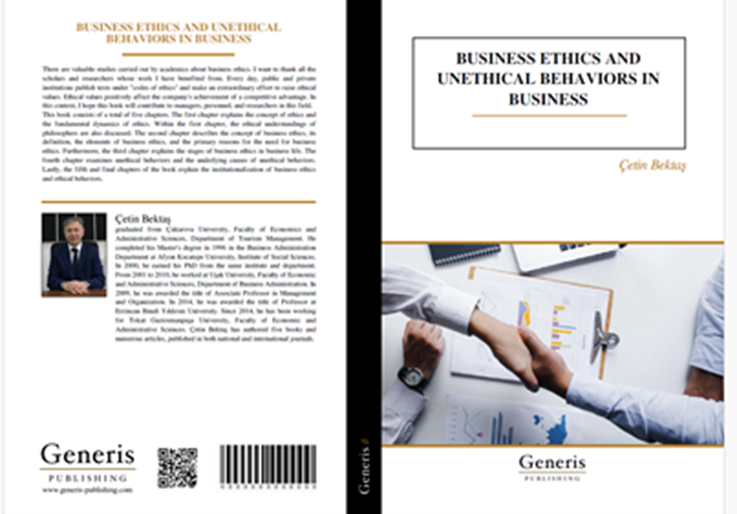Does Foreign Direct Investment Increase Ecological Footprint? An Analysis of Countries Attracting the High Foreign Direct Investment
Keywords:
Foreign Direct Investments, Ecological footprint, Panel ARDLAbstract
This study aimed to investigate the impact of foreign direct investments on the ecological footprint. For this purpose, data for the period 1990-2021 of the 19 countries that attracting the high Foreign Direct Investment (FDI) were used. In order to determine the short and long-term effects on the FDI-ecological footprint relationship, the Panel Lag Distributed Autoregressive Model (Panel ARDL) was analyzed using the Pooled Mean Group (PMG) estimator. The analysis findings show that FDI have a positive effect on the ecological footprint. The fact that FDI increases the ecological footprint in the selected group of countries means that these countries are subject to environmental degradation and pollution by FDI. In addition, while economic growth, one of the explanatory variables used in the model, has a positive relationship with the ecological footprint, renewable energy has a negative relationship. As a result of the study, various policy recommendations were made to host countries to reduce the ecological footprint caused by FDI.
References
Abdul-Gafaru, A. (2006). Are Multinational Corporations Compatible with Sustainable Development? The Experience of Developing Countries. Georgia Tech Center for International Business Education and Research, Working Paper 001-07/08.
Adeel-Farooq, R. M., Riaz, M. F. and Ali, T. (2021). Improving the Environment Begins at Home: Revisiting the Links between FDI and Environment. Energy, 215: 119150.
Akbostancı, E., Türüt-Aşık, S. and Tunç, G. İ. (2009). The Relationship between Income and Environment in Turkey: Is there an Environmental Kuznets Curve? Energy policy, 37(3): 861-867.
Akyol Özcan, K. (2024). Determinants of Ecological Footprint: A Quantile Regression Approach. Systems, 12(2): 59.
Arogundade, S., Mduduzi, B. and Hassan, A. S. (2022). Spatial Impact of Foreign Direct Investment on Ecological Footprint in Africa. Environmental Science and Pollution Research, 29(34): 51589-51608.
Azam, A., Rafiq, M., Shafique, M., Ateeq, M. and Yuan, J. (2021). Investigating the impact of renewable electricity consumption on sustainable economic development: A panel ARDL approach. International Journal of Green Energy, 18(11): 1185–1192.
Bakkal, H. (2022). Ekonomik Büyüme, Doğrudan Yabancı Sermaye Yatırımları, Finansal Gelişme ve Ekolojik Ayak İzi Arasındaki İlişki: ABD ve Çin Üzerine Bir Analiz. Anadolu Üniversitesi İktisadi ve İdari Bilimler Fakültesi Dergisi, 23(3): 366-386.
Bakhsh, K. Rose, S. Ali, MF. Ahmad, N. and Shahbaz, M. (2017). Economic growth, CO2 emissions, renewable waste and FDI relation in Pakistan: New evidences from 3SLS. J Environ Manag, 196:627–632
Baloch, M.A., Zhang, J., Iqbal, K. and Iqbal, Z. (2019). The Effect of Financial Development on Ecological Footprint in BRI Countries: Evidence from Panel Data Estimation. Environmental Science and Pollution Research, 26: 6199-6208.
Başar, S. ve Temurlenk, M. S. (2007). Çevreye Uyarlanmış Kuznets Eğrisi: Türkiye Üzerine Bir Uygulama. Atatürk Üniversitesi İktisadi ve İdari Bilimler Dergisi, 21(1): 1-12.
Bibi, F. and Jamil, M. (2021). Testing Environment Kuznets Curve (EKC) Hypothesis in Different Regions. Environmental Science and Pollution Research, 28(11): 13581-13594.
Blomquist, J. and Westerlund, J. (2013). Testing slope homogeneity in large panels with serial correlation. Economics Letters, 121: 374-378.
Bo, S. (2011). A Literature Survey on Environmental Kuznets Curve. Energy Procedia, 5: 1322-1325.
Bozoklu, S., Demir, A. O. and Ataer, S. (2020). Reassessing the Environmental Kuznets Curve: A Summability Approach for Emerging Market Economies. Eurasian Economic Review, 10: 513-531.
Bulus, G. C. and Koc, S. (2021). The Effects of FDI and Government Expenditures on Environmental Pollution in Korea: the Pollution Haven Hypothesis Revisited. Environmental Science and Pollution Research, 28(28): 38238-38253.
Chancel, L. (2022). Global carbon inequality over 1990-2019. Nature Sustainability, 5(11): 931-938.
Chowdhury, M. A. F., Shanto, P. A., Ahmed, A. and Rumana, R. H. (2021). Does Foreign Direct Investments Impair the Ecological Footprint? New Evidence from the Panel Quantile Regression. Environmental Science and Pollution Research, 28: 14372-14385.
Chung, S. (2014). Environmental Regulation and Foreign Direct Investment: Evidence from South Korea. Journal of Development Economics, 108: 222-236.
Cole, M. A. (2004). Trade, the Pollution Haven Hypothesis and the Environmental Kuznets Curve: Examining the Linkages. Ecological Economy, 48: 71-81.
Cole, M. A., Elliott, R. J. and Zhang, J. (2011). Growth,
Foreign Direct Investment, and the Environment: Evidence from Chinese Cities. Journal of Regional Science, 51(1): 121-138.
Copeland, B. R. and Taylor, M. S. (1995). Trade and the Environment: A Partial Synthesis. American Journal of Agricultural Economics, 77(3): 765-771.
Demena, B. A. and Afesorgbor, S. K. (2020). The effect of FDI on Environmental Emissions: Evidence from a Meta-Analysis. Energy Policy, 138: 111-192.
Demirguc-Kunt, A. and Huizinga, H. (2001). The taxation of domestic and foreign banking. Journal of Public Economics, 79(3), 429-453.
Demirgüneş, K. (2015). Determinants of Target Dividend Payout Ratio: A Panel Autoregressive Distributed Lag Analysis. International Journal of Economics and Financial Issues, 5(2): 418-426.
Destek, M. A. and Okumus, I. (2019). Does Pollution Haven Hypothesis Hold in Newly Industrialized Countries? Evidence from Ecological Footprint. Environmental Science and Pollution Research, 26: 23689-23695.
Destek, M. A. and Sinha, A. (2020). Renewable, Non-renewable Energy Consumption, Economic Growth, Trade Openness and Ecological Footprint: Evidence from Organisation for Economic Co-operation and Development Countries. Journal of Cleaner Production, 242: 118537.
Dinda, S. (2004). Environmental Kuznets Curve Hypothesis: a Survey. Ecological Economics, 49(4): 431-455.
Doytch, N. (2020). The Impact of Foreign Direct Investment on the Ecological Footprints of Nations. Environmental and Sustainability Indicators, 8: 100085.
Doytch, N. and Uctum, M. (2011). Globalization and the environmental spillovers of sectoral FDI. Unpublished manuscript.
Duman, E. (2023). Seçilmiş Ekonomik Değişkenlerin Ekolojik Ayak İzine Etkisinin analizi: BRICS-T Ülkeleri Örneği. Sosyoekonomi, 31(58): 277-288.
Eskeland, G. S., Harrison, A. E. (2003). Moving to Greener Pastures? Multinationals and the Pollution Haven Hypothesis. Journal of Development Economy, 70 (1): 1-23.
Eweade, B. S., Karlilar, S., Pata, U. K., Adeshola, I. and Olaifa, J. O. (2023). Examining the Asymmetric Effects of Fossil Fuel Consumption, Foreign Direct Investment, and Globalization on Ecological Footprint in Mexico. Sustainable Development. 32: 2899-2909.
Fan, C. S. and Hu, Y. (2007). Foreign Direct Investment and Indigenous Technological Efforts: Evidence from China. Economics Letters, 96(2): 253-258.
Friedman, J., Gerlowski, D. A. and Silberman, J. (1992). What Attracts Foreign Multinational Corporations? Evidence from Branch Plant Location in the United States. Journal of Regional Science, 32(4): 403-418.
Gessesse A.T., He G. (2020). Analysis of Carbon Dioxide Emissions, Energy Consumption, and Economic Growth in China. Agricultural Economics-Czech, 66: 183-192.
Global Footprint Network (2024). Data and Methodology, https://www.footprintnetwork.org/resources/data/ (12/07/2024)
Grossman, G.M. and Krueger, A.B. (1991). Environmental Impacts of A North American Free Trade Agreement. National Bureau Economic Research, 39(14): 1-57.
Guo, X. and Shahbaz, M. (2024). The existence of environmental Kuznets curve: Critical look and future implications for environmental management. Journal of Environmental Management, 351, 119648.
Hanif, I., Raza, SMF., Gago-de-Santos, P., Abbas, Q. (2019). Fossil Fuels, Foreign Direct Investment, and Economic Growth have Triggered CO2 Emissions in Emerging Asian Economies: Some Empirical Evidence. Energy, 171:493–501.
Iheonu, C. O., Emeka, E. T., Asongu, S. and Okwoche, P. (2023). Foreign Investment, International Trade and Environmental Sustainability: Exploring Ecological Footprints in 37 African Countries. Environmental Processes, 10(4): 48.
IPCC (2023). Climate Change 2023: Synthesis Report, [Core Writing Team, H. Lee and J. Romero (eds.)]. IPCC, Geneva, Switzerland. https://www.ipcc.ch/report/ar6/syr/downloads/report/IPCC_AR6_SYR_LongerReport.pdf (Erişim Tarihi: 08.08.2024).
Jorgenson, A.K. (2007). Does Foreign Investment Harm the Air We Breath and the Water We Drink. Organiztion & Environment, 20, 137-156.
Khan, A., Chenggang, Y., Hussain, J. and Bano, S. (2019). Does Energy Consumption, Financial Development, and Investment Contribute to Ecological Footprints in BRI Regions? Environmental Science and Pollution Research, 26(36): 36952-36966.
Khan, I., Hou, F., Zakari, A., Irfan, M. and Ahmad, M. (2022). Links Among energy intensity, non-linear financial development, and environmental sustainability: New evidence from Asia Pacific Economic Cooperation countries. Journal of Cleaner Production, 330: 129747.
Khan, M. A. and Ozturk, I. (2020). Examining foreign direct investment and environmental pollution linkage in Asia. Environmental Science and Pollution Research, 27(7): 7244-7255.
Kızılgöl, Ö. and Öndes, H. (2022). Factors Affecting the Ecological Footprint: a Study on the OECD Countries. Science of the Total Environment, 849: 157757.
Kirikkaleli, D. and Adebayo, T. S. (2021). Do Renewable Energy Consumption and Financial Development Matter for Environmental Sustainability? New global evidence. Sustainable Development, 29(4): 583-594.
Koçak, E. (2024). Yenilenebilir Enerjinin Ekolojik Ayak İzi Üzerine Etkisi: Türkiye Örneği. Politik Ekonomik Kuram, 8(1): 256-265.
Letchumanan, R. and Kodama, F. (2000). Reconciling the Conflict between the Pollution Haven Hypothesis and an Emerging Trajectory of International Technology Transfer. Research Policy, 29(1): 59-79.
Li, M., Badeeb, R. A., Dogan, E., Gu, X. and Zhang, H. (2023). Ecological Footprints and Sustainable Environmental Management: A Critical View of China's economy. Journal of Environmental Management, 347: 118994.
Li, R., Wang, Q. and Guo, J. (2024). Revisiting the Environmental Kuznets Curve (EKC) Hypothesis of Carbon Emissions: Exploring the Impact of Geopolitical Risks, Natural Resource Rents, Corrupt Governance, and Energy Intensity. Journal of Environmental Management, 351: 119663.
Liu, Q. and Wang, Q. (2017). How China Achieved its 11th Five-year Plan Emissions Reduction Target: a Structural Decomposition Analysis of Industrial SO2 and Chemical Oxygen Demand. Science of the Total Environment, 574, 5, 1104-1116.
Liu, H. and Kim, H. (2018). Ecological Footprint, Foreign Direct Investment, and Gross Domestic Production: Evidence of Belt & Road Initiative Countries. Sustainability, 10(10): 3527.
Liu, Y., Sadiq, F., Ali, W. and Kumail, T. (2022). Does Tourism Development, Energy Consumption, Trade Openness and Economic Growth Matters for Ecological Footprint: Testing the Environmental Kuznets Curve and Pollution Haven Hypothesis for Pakistan. Energy, 245: 123208.
Mesagan, E. P., Isola, W. A. and Ajide, K. B. (2019). The Capital Investment Channel of Environmental Improvement: Evidence from BRICS. Environment, Development and Sustainability, 21: 1561-1582.
Murshed, M., Nurmakhanova, M., Al-Tal, R., Mahmood, H., Elheddad, M. and Ahmed, R. (2022). Can Intra-regional Trade, Renewable Energy Use, Foreign Direct Investments, and Economic Growth Mitigate Ecological Footprints in South Asia? Energy Sources, Part B: Economics, Planning, and Policy, 17(1).
Nasir, M.A., Duc Huynh, T.L. and Xuan Tram, H.T. (2019). Role of Financial Development, Economic Growth and Foreign Direct Investment in Driving Climate Change: a Case of Emerging ASEAN. Journal of Environmental Management, 242: 131-141,
Naqvi, S.A.A., Shah, S.A.R., Anwar, S. and Raza, H. (2021). Renewable Energy, Economic Development, and Ecological Footprint Nexus: Fresh Evidence of Renewable Energy Environment Kuznets Curve (RKC) from Income Groups. Environmental Science and Pollution Research, 28, 2031-2051.
Omri A, Nguyen DK, Rault C (2014). Causal interactions between CO2 emissions, FDI, and economic growth: evidence from dynamic simultaneous-equation models. Econ Model, 42:382–389
Pao, H.-T. and Tsai, C.-M. (2011). Multivariate Granger causality between CO2 emissions, energy consumption, FDI (foreign direct investment) and GDP (gross domestic product): evidence from a panel of BRIC countries. Energy, 36(1): 685-693
Padhan, L., and Bhat, S. (2024). Nexus between Foreign Direct Investment and Ecological Footprint in BRICS and Next-11: the Moderating role of Green Innovation. Management of Environmental Quality: An International Journal, 35(4): 799-817.
Pata, U. K. (2018). The Influence of Coal and Noncarbohydrate Energy Consumption on CO2 Emissions: Revisiting the Environmental Kuznets Curve Hypothesis for Turkey. Energy, 160: 1115-1123.
Pata, U. K., Erdogan, S., and Ozkan, O. (2023). Is Reducing Fossil Fuel Intensity Important for Environmental Management and Ensuring Ecological Efficiency in China? Journal of Environmental Management, 329: 117080.
Pesaran, M. H., and Smith, R. P. (1995). Estimating Long-Run Relation-ships From Dynamic Heterogeneous Panels. Journal of Econometrics, 68: 79-113.
Pesaran, M. Hashem, Shin, Y. R. and Smith, P. (1999). Pooled Mean Group Estimation Of Dynamic Heterogeneous Panels. Journal of the American Statistical Association, 94 (446): 621-634.
Pesaran, M. H. (2004). General Diagnostic Tests for Cross Section Dependence in Panels. Cambridge Working Papers. Economics, 1240(1): 1.
Pesaran, M. H. (2006). Estimation and Inference in Large Heterogeneous Panels with a Multifactor Error Structure. Econometrica, 74(4): 967-1012.
Pesaran, M. H. (2007). A Simple Panel Unit Root Test in the Presence of Cross‐section Dependence. Journal of Applied Econometrics, 22(2): 265-312.
Pesaran, M. H. and Yamagata, T. (2008). Testing Slope Homogeneity in Large Panel. Journal of Econometrics, 142 (1):50-93.
Raghutla, C., Padmagirisan, P., Sakthivel, P., Chittedi, K. R. and Mishra, S. (2022). The Effect of Renewable Energy Consumption on Ecological Footprint in N-11 Countries: Evidence from Panel Quantile Regression Approach. Renewable Energy, 197: 125-137.
Raihan, A. (2024). Influences of Foreign Direct Investment and Carbon Emission on Economic Growth in Vietnam. Journal of Environmental Science and Economics, 3(1): 1-17.
Rej, S., Bandyopadhyay, A., Das, N., Hossain, M. E., Islam, M. S., Bera, P., and Yeediballi, T. (2023). The Asymmetric Influence of Environmental-Related Technological Innovation on Climate Change Mitigation: What Role Do FDI and Renewable Energy Play?. Environmental Science and Pollution Research, 30(6): 14916-14931.
Roy, A. (2024). The Impact of Foreign Direct Investment, Renewable and non-Renewable Energy Consumption, and Natural Resources on Ecological Footprint: an Indian Perspective. International Journal of Energy Sector Management, 18(1): 141-161.
Salihu, I. A., Annuar, H. A. and Obid, S. N. S. (2015). Foreign Investors' Interests and Corporate Tax Avoidance: Evidence from an Emerging Economy. Journal of Contemporary Accounting & Economics, 11(2): 138-147.
Saqib, N., Ozturk, I., Usman, M., Sharif, A. and Razzaq, A. (2023). Pollution Haven or Halo? How European Countries Leverage FDI, Energy, and Human Capital to Alleviate Their Ecological Footprint. Gondwana Research, 116: 136-148.
Seyidoğlu, H. (2015). Uluslararası İktisat Teori, Politika ve Uygulama, 20.baskı, İstanbul: Güzem Can Yayınları.
Scrieciu, Ş. (2015). Measuring Environmental Action and Economic Performance in Developing Countries. (GGKP Research Committee on Trade and Competitiveness. Working Pape 01/2015). UNEP / Green Growth Knowledge Platform: Geneva, Switzerland. https://discovery.ucl.ac.uk/id/eprint/10073124/ (Erişim Tarihi: 02.08.2024).
Shaari, M. S., Abdul Karim, Z. and Zainol Abidin, N. (2020). The Effects of Energy Consumption and National Output on CO2 Emissions: New Evidence from OIC Countries Using a Panel ARDL Analysis. Sustainability, 12 (8), 3312.
Shahbaz, M., Nasreen, S., Abbas, F. and Anis, O. (2015). Does Foreign Direct Investment Impede Environmental Quality in High, Middle, and Low-Income Countries? Energy Economics, 51, 275-287.
Shahbaz, M., Shafiullah, M., Khalid, U. and Song, M. (2020). A Nonparametric Analysis of Energy Environmental Kuznets Curve in Chinese Provinces. Energy Economics, 89, 104814.
Sharma, R., Sinha, A. and Kautish, P. (2021). Does Renewable Energy Consumption Reduce Ecological Footprint? Evidence from Eight Developing Countries of Asia. Journal of Cleaner Production, 285: 124867.
Solarin, S. A. and Al-Mulali, U. (2018). Influence of Foreign Direct Investment on Indicators of Environmental Degradation. Environmental Science and Pollution Research, 25: 24845-24859.
Sun, H., Liu, Z. and Chen, Y. (2020). Foreign Direct Investment and Manufacturing Pollution Emissions: A Perspective from Heterogeneous Environmental Regulation. Sustainable Development, 28(5): 1376-1387.
Udemba, E. N. (2021). Nexus of Ecological Footprint and Foreign Direct Investment Pattern in Carbon Neutrality: New Insight for United Arab Emirates (UAE). Environmental Science and Pollution Research, 28: 34367-34385.
Ullah, S., Nadeem, M., Ali, K. and Abbas, Q. (2022). Fossil fuel, industrial growth and inward FDI impact on CO2 emissions in Vietnam: testing the EKC hypothesis. Management of Environmental Quality: An International Journal, 33(2): 222-240.
UNCTAD (2024), Foreign Direct Investment, https://hbs.unctad.org/foreign-direct-investment/ (Erişim Tarihi: 05.07.2024)
Usman, M. and Hammar, N. (2021). Dynamic Relationship between Technological Innovations, Financial Development, Renewable Energy, and Ecological Footprint: Fresh Insights Based on the STIRPAT model for Asia Pacific Economic Cooperation Countries. Environmental Science and Pollution Research, 28(12): 15519-15536.
Van Tran, H., Tran, A.V., Bui Hoang, N. and Mai, T.N.H. (2024). Asymmetric Effects of Foreign Direct Investment and Globalization on Ecological Footprint in Indonesia. PLoS ONE 19(1): 0297046.
Wackernagel, M. and Rees, W. (1996). Our Ecological Footprint: Reducing Human Impact on the Earth, New Society Publiher, Canada.
Wang, D.T. and Chen, W. Y. (2014). Foreign Direct Investment, Institutional Development, and Environmental Externalities: Evidence from China. Journal of Environmental Management, 135: 81-90.
Wang, Q., Zhang, F. and Li, R. (2023). Revisiting the Environmental Kuznets Curve Hypothesis in 208 Counties: The Roles of Trade Openness, Human Capital, Renewable Energy and Natural resource rent. Environmental Research, 216: 114637.
Xie, Q., Wang, X. and Cong, X. (2020). How does Foreign Direct Investment Affect CO2 Emissions in Emerging countries? New Findings from a Nonlinear Panel Analysis. Journal of Cleaner Production, 249: 119422.
Xing, Y. and Kolstad, C. D. (2002). Do Lax Environmental Regulations Attract Foreign Investment? Environmental and Resource Economics, 21: 1-22.
Xu, L., Wang, X., Wang, L. and Zhang, D. (2022). Does Technological Advancement Impede Ecological Footprint Level? The role of Natural Resources Prices Volatility, Foreign Direct Investment and Renewable Energy in China. Resources Policy, 76: 102559.
Yandle, B., Bhattarai, M. and Vijayaraghavan, M. (2004). Environmental Kuznets Curves: a Review of Findings, Methods, and Policy Implications. PERC Research study 02-1 update. IWMI Research Reports, (H044740).
Yerdelen Tatoğlu, F. (2020). Panel Zaman Serileri Analizi: Stata Uygulamalı. 3. Basım, İstanbul: Beta Yayınları.
Zafar, M. W., Zaidi, S. A. H., Khan, N. R., Mirza, F. M., Hou, F. and Kirmani, S. A. A. (2019). The Impact of Natural Resources, Human Capital, and Foreign Direct Investment on the Ecological Footprint: the Case of the United States. Resources Policy, 63: 101428.
Zarsky, L. (1999). Havens, Halos and Spaghetti: Untangling the Evidence about Foreign Direct Investment and the Environment. Foreign Direct Investment and the Environment, 13(8): 47-74.
Zeng, D. Z. and Zhao, L. (2009). Pollution Haven Sand Industrial Agglomeration. Journal of Environmental Economy Management, 58: 141-153.
Zeng, K. and Eastin, J. (2012). Do Developing Countries Invest up? The Environmental Effects of Foreign Direct Investment from Less-developed Countries. World Development, 40(11): 2221-2233.
Zhu, H., Duan, L., Guo, Y. and Yu, K. (2016). The Effects of FDI, Economic Growth and Energy Consumption on Carbon Emissions in ASEAN-5: Evidence from Panel Quantile Regression. Economic Modelling, 58: 237-248.
Downloads
Published
How to Cite
Issue
Section
License
Copyright (c) 2024 Journal of Academic Opinion

This work is licensed under a Creative Commons Attribution 4.0 International License.





